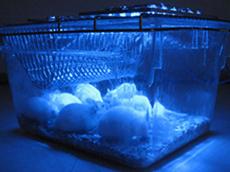Genes at the flick of a light switch
Researchers from ETH Zurich have fitted human cells with a synthetic signalling cascade that can be used to switch on and regulate genes via blue light. This “gene light switch” makes interesting therapies possible, which could be used to treat type 2 diabetes, for instance.

The latest feat to come out of Martin Fussenegger’s lab almost sounds like science fiction: the professor of biotechnology and bioengineering and his team have constructed a genetic network in living cells that can be used to switch on and regulate specific genes via blue light. However, rather than create the whole network the bioengineers have merely connected up natural signalling pathways – one from the eye and one from the immune system. The cells are inserted under the skin, complete with the functioning gene network, and blue light is shone onto the implant from outside. This enables the researchers to control the target gene with extreme precision, reports first author Haifeng Ye from Fussenegger’s team in the latest issue of Science.
The “gene light switch” the scientists use to switch on the network is made of melanopsin, a protein found in the retina of the human eye that forms a complex with Vitamin A. When blue light hits this complex, the first signalling cascade is activated, which ensures that calcium accumulates inside the cell – a process that also takes place naturally in the eye and is responsible for setting the biological clock in the brain every day. However, the scientists have re-connected it – to a signalling pathway that plays a key role in immunoregulation.
Light against winter blues
The calcium inside the cell activates an enzyme that separates the phosphate group (P) from the protein NFAT-P. NFAT thus enters the cell nucleus, where it binds to a synthetic control sequence and switches on the target gene the researchers have introduced. The gene becomes active and the cell produces numerous copies of the protein, for which the gene is the blueprint. By controlling the amount of light and its intensity, the researchers can also regulate how much of the protein is produced. Switching the gene off is easy: light off, gene off. After all, without light melanopsin is no longer stimulated, no more calcium accumulates in the cells and the signal cascade is interrupted.
This artificial signalling cascade is synthesised in human cells which, suitably parcelled, are implanted in mice. The blue light reaches the cell implants either via an ultra-thin glass fibre optic cable or, if the implant is placed directly under the skin, simply by placing the animals under a blue lamp. For the light source, the researchers used commercially available LEDs or a blue-light lamp that is used to combat winter depression. Since it does not contain a UV proportion, the light is not harmful for the skin.
Diabetes treatment conceivable
In their experiments with cell cultures and mice, the researchers tested the light-controlled production of GLP-1, a hormone that controls the production of insulin directly and thus regulates the blood glucose level. And it showed the researchers that their approach works: the GLP-1 that was upregulated using light helped diabetic mice to improve the organism’s insulin production, quickly remove the glucose from the blood and restore the blood-sugar balance in the organism.
Martin Fussenegger can imagine the GLP-1 gene therapy his team has developed replacing the classical injection of insulin for diabetics one day. People suffering from type 2 diabetes, for instance, could have an implant placed under the skin as outpatients. A black plaster containing LED lamps shields the relevant area of the skin from the daylight. As and when needed, such as after a meal, for instance, the patient switches on the LED lamps by pushing a button and shines them on the implant for a few minutes to stimulate the production of GLP-1. As soon as enough of the hormone is circulating in the body, the patient simply switches the lamps back off. “That’s still the stuff of science fiction, though,” stresses the ETH-Zurich professor; it will be quite some time before we see a product like this on the market.
Further reading
Ye H, Daoud-El Baba M, Peng RW & Fussenegger M. A Synthetic Optogenetic Transcription Device Enhances Blood-Glucose Homeostasis in Mice. Science online Publication 24th june 2011, DOI: 10.1126/science.1203535







READER COMMENTS